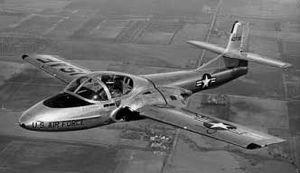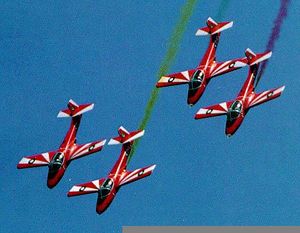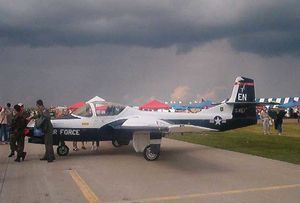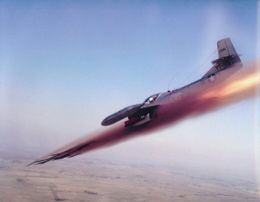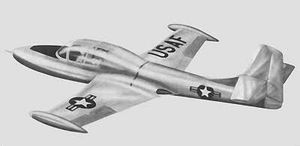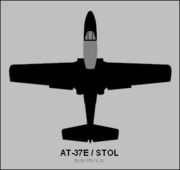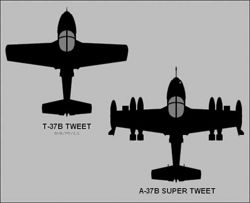PlaneSpottingWorld welcomes all new members! Please gives your ideas at the Terminal.
T-37 Tweet
- For the Soviet light tank, see T-37 tank
| Cessna T-37 | |
|---|---|
| T-37s in formation. | |
| Type | Military trainer aircraft |
| Manufacturer | Cessna |
| Maiden flight | October 1954 |
| Introduced | 1957 |
| Status | 500 in active service |
| Primary users | United States Air Force United States Navy |
| Produced | 1955-???? |
| Number built | >1,000 |
The Cessna T-37/A-37, known in various forms as the Tweety Bird, Tweet, Dragonfly, or Super Tweet, is one of the most prominent of the trainer-attack type aircraft. This small, economical dual-engine jet aircraft flew for decades as a primary trainer for the United States Air Force, and served with distinction in an attack role during the Vietnam War. The T-37/A-37 has also provided a wide range of service in the air forces of other nations.
Fifty two years after its first flight, the T-37 is the only currently-serving U.S. military aircraft built by Cessna since the retirement of the T-41. It gives United States Air Force-trained primary pilot training students the necessary experience needed before moving on to the Northrop T-38 Talon, Beech T-1A Jayhawk, Bell UH-1F Huey, United States Navy Beech T-44 Pegasus, or other advanced Navy, Marine Corps or Allied trainers. Over 1,000 planes were built, with more than 500 still serving in the United States Air Force. In 2001, the T-37 began to be replaced by the Raytheon T-6 Texan II, at Laughlin Air Force Base in Texas. The last T-37 from Laughlin was flown on December 1, 2004 to be retired at Davis-Monthan Air Force Base, Arizona. Transition from the T-37 to the T-6 at Vance Air Force Base, Oklahoma began in late 2004.
Contents
Origins: Model 318 (XT-37)
The Cessna Aircraft Company of Wichita, Kansas earned a good reputation with the United States Army during World War II with the company's highly-regarded utility, light transport, and observation aircraft, particularly the "O-1 Bird Dog" series.
In the spring of 1952, the United States Air Force (USAF) issued a request for proposals for a "Trainer Experimental (TX)" program, specifying a lightweight two-seat basic trainer for introducing USAF cadets to jet aircraft.
Cessna responded to the TX request with a twin-jet design that featured side-by-side seating. The USAF liked the Cessna design, which was given the company designation of "Model 318", and particularly liked the side-by-side seating since it let the student and instructor interact more closely than with tandem seating. In the spring of 1954, the USAF awarded Cessna a contract for three prototypes of the Model 318, and a contract for a single static test aircraft. The Air Force designated the type as XT-37.
The first XT-37 first flew in October 1954. It had a straight low wing, with the engines buried in the wing roots; a clamshell-type canopy, hinged to open vertically to the rear; a control layout similar to that of contemporary operational USAF aircraft; ejection seats; and tricycle landing gear with a wide track of 4.3 m (14 ft).
The wide track and a steerable nosewheel made the aircraft easy to handle on the ground, and the short landing gear avoided need for access ladders and service stands. The aircraft was designed to be simple to maintain, with more than a hundred access panels and doors. An experienced ground crew could change an engine in about a half hour.
The XT-37 was very aerodynamically clean, and so an air brake was fitted behind the nosewheel door to reduce landing speed. As the engine intakes were close to the ground because the landing gear was short, the XT-37 had screens that pivoted up over the intakes from underneath when the landing gear was extended, to prevent foreign object damage.
The XT-37 was fitted with two Continental-Teledyne J-69-T-9 turbojet engines with 4.1 kN (920 lbf) thrust each. These were French Turbomeca Marboré engines, built under license. The engines had thrust deflectors to allow the engines to remain spooled up during landing approach, permitting shorter landings while still allowing the aircraft to easily make another "go-round" in case something went wrong. Total weight of the XT-37 was 2.27 tonnes (5,000 lb).
Tests showed the XT-37 had a maximum speed of 630 km/h (390 mph) at altitude, with a range of 1,500 km (935 mi). The aircraft was unpressurized, and so limited to a ceiling of 7.6 km (25,000 ft) by USAF regulations.
The initial prototype crashed during spin tests. The later prototypes had new features to improve handling, including long strakes along the nose, and an extensively redesigned and enlarged tail. After these modifications, the USAF found the aircraft acceptable to their needs, and ordered it into production as the T-37A. Even so, the aircraft remained tricky in recovering from a spin; the recovery procedure was complex compared with most aircraft.
T-37A, T-37B, T-37C
The production T-37A was similar to the XT-37 prototypes, except for minor changes to fix problems revealed by the flight test program. The first T-37A was completed in September 1955, executing its maiden flight that year, and was delivered to the Air Force in June 1956. The USAF began cadet training in the T-37A during 1957.
Instructors and students considered the T-37A an extremely pleasant aircraft to fly. It handled well and was agile and responsive, though it was definitely not overpowered. It was capable of all traditional aerobatic maneuvers.
The T-37A had one very noticeable drawback: it was very noisy, even by the standards of a jet aircraft. The intake of air into its small turbojets emitted a high-pitched shriek that led some to describe the trainer as a "Screaming Mimi", and it was referred to as the "6,000 pound dog whistle" or "Converter" (converts fuel and air into noise and smoke.) The piercing whistle quickly gave the T-37 its name: "Tweety Bird", or just "Tweet". The Air Force spent a lot of time and money sound-proofing buildings at bases where the T-37 was stationed, and ear protection was mandatory for all ground crew and pilots when near an operating aircraft.
The Air Force ordered 444 T-37As, with the last produced in 1959. During 1957, the US Army evaluated three T-37As for battlefield observation and other combat support roles, but eventually procured the Grumman OV-1 Mohawk for the mission instead.
The Air Force liked the T-37A, but felt it was underpowered. As a result, the service ordered an improved version, the T-37B, with uprated J-69-T-25 engines. The new engines provided about ten percent more thrust and better reliability. Improved avionics were also specified for the new variant.
The first T-37B was delivered in 1959. A total of 552 newly-built T-37Bs were constructed through 1973. All surviving T-37As were eventually upgraded to the T-37B standard as well.
Due to a series of accidents caused by bird strikes between 1965 and 1970, all T-37s were later retrofitted with a new windscreen made of Lexan polycarbonate plastic 12.5 mm (½in) thick, which could tolerate the impact of a 1.8 kg (4 lb) bird at a relative speed of 460 km/h (288 mph).
In 1962, Cessna suggested the T-37B as a replacement for the North American F-100 Super Sabre as the primary aircraft for the USAF aerobatic demonstration team, the Thunderbirds. The T-37B was proven as an aerobatic aircraft, was economical to operate and support, and could be flown from small airports. However, the USAF was satisfied with the F-100 and were not interested in trading it in for the Tweet. Its later decision to switch to the F-105 Thunderchief met with disastrous problems, though the supersonic T-38 trainer would later be selected as an economical alternative to front line fighters.
The T-37A and T-37B had no built-in armament and no stores pylons for external armament. In 1961, Cessna began developing a modest enhancement of the T-37 for use as a weapons trainer. The new variant, the T-37C, was intended for export and could be used for light attack duties in a pinch.
The prototype T-37C was a modified T-37B. The primary changes included stronger wings, with a stores pylon under each wing, outboard of the main landing gear well. The T-37C could also be fitted with wingtip fuel tanks, each with a capacity of 245 l (65 US gallons), that could be dropped in an emergency.
A computing gunsight and gun camera were added. The T-37C could also be fitted with a reconnaissance camera mounted inside the fuselage.
The primary armament of the T-37C was the General Electric "multi-purpose pod", which carried a 12.7 mm (0.50 caliber) machine gun with 200 rounds; two 70 mm (2.75 in) folding-fin rockets; and four practice bombs. Other stores, such as folding-fin rocket pods or even Sidewinder air-to-air missiles, could be carried as well.
The changes increased the weight of the T-37C by 650 kg (1,430 lb). As the engines were not upgraded, this reduced top speed to 595 km/h (370 mph), though the wingtip tanks increased maximum range to 1,770 km (1,100 mi).
T-37s, including both new-build and ex-USAF aircraft, were supplied to a number of foreign operators, including:
- Brazil: 65 T-37Cs, later passing 30 on to South Korea and 12 on to Paraguay.
- Burma: 12 T-37Cs.
- Cambodia: 4 T-37Bs.
- Chile: 32 aircraft, including 20 T-37Bs and 12 T-37Cs.
- Ecuador: 20 aircraft including 10 A-37's and 10 T-37B's.
- Colombia: 14 aircraft, including 4 T-37Bs and 10 T-37Cs.
- Greece: 32 aircraft, including 8 T-37Bs and 24 T-37Cs.
- Jordan: 15 aircraft, apparently ex-USAF T-37Bs.
- Pakistan: 63 aircraft, including 24 T-37Bs and 39 T-37Cs.
- Peru: 32 T-37Bs.
- Portugal: 30 T-37Cs.
- South Korea: 25 T-37Cs, not counting the 30 bought from Brazil later.
- South Vietnam: 24 T-37Bs.
- Thailand: 16 aircraft, including 10 T-37Bs and 6 T-37Cs.
- Turkey: 50 T-37Cs.
- West Germany: 47 T-37Bs, all operated in the US with USAF markings.
The Portuguese Air Force used the T-37C as the primary aircraft for their aerobatic demonstration team, the Asas de Portugal (Wings of Portugal) starting in 1977, and put on hundreds of shows all over Europe with these brightly-painted planes.
T-37 production ended in 1975. The list of exports above amounts to 273 T-37Cs. Adding this to the 444 T-37As and 552 T-37Bs gives a total of 1,269 aircraft built.
The type remained in service with the USAF into the 21st century, having survived various attempts to find a replacement. However, the Tweet is now being phased out in favor of the turboprop-powered Raytheon T-6A Texan II (a turboprop aircraft with more power and modern avionics), going into retirement after over four decades of reliable service.
A-37 Dragonfly
The growing American military involvement in Vietnam in the early 1960s led to strong interest in "counter-insurgency (COIN)" aircraft, and in late 1962 the US Air Force's Special Air Warfare Center at Eglin Air Force Base in Florida evaluated two T-37Cs for the role.
The Air Force found the T-37 promising, but wanted an improved version of the aircraft that could carry a much larger warload, and had much greater endurance, as well as better short-field performance. This meant a heavier aircraft with more powerful engines, and during 1963 the Air Force awarded a contract to Cessna for two T-37s with the necessary modifications.
The two prototypes were given the designation YAT-37D. Changes included:
- Further strengthening of the wings.
- Fitting of three stores pylons on each wing, for a total of six.
- Larger wingtip fuel tanks with a capacity of 360 l (95 US gallons).
- A General Electric GAU-2B/A 7.62 m Gatling "Minigun" with a rate of fire of 3,000 rounds a minute and 1,500 rounds of ammunition. The weapon was fitted in the right side of the aircraft's nose behind a large, convenient access panel. A gunsight and gun camera were also fitted.
- An improved avionics suite for battlefield communications, navigation, and targeting.
- Ruggedized landing gear for rough-field operation.
These changes meant a drastic increase in aircraft weight, and the aircraft now had to carry a serious warload as well, so Cessna replaced the two Continental J-69 engines with General Electric J85-J2/5 turbojet engines with 10.7 kN (2,400 lbf) thrust each, twice as powerful as the old Continental J-69s.
The first YAT-37D flew in October 1964, followed a year later by the second prototype. The second prototype had four stores pylons under each wing, rather than three, and the first prototype was upgraded to this configuration as well.
Test results were good, but USAF interest in COIN aircraft had faded for the moment. The program went into limbo for a time, with the second prototype "put out to pasture" at the Air Force Museum at Wright-Patterson Air Force Base in Ohio.
However, the war in Southeast Asia continued to escalate. Losses of Douglas A-1 Skyraider close-support aircraft in US and South Vietnamese hands proved greater than anticipated, and so USAF interest in COIN aircraft revived. The YAT-37D seemed like a promising candidate for the job, but the Air Force felt the only way to be sure was to evaluate the aircraft in combat.
As a result, the USAF issued a contract to Cessna for a preproduction batch of 39 YAT-37Ds, with a few minor changes relative to the prototypes, to be rebuilt from existing T-37Bs. These aircraft were initially designated AT-37D, but the designation was quickly changed to A-37A. The second prototype YAT-37D was pulled out of the Air Force Museum and upgraded to A-37A standards as part of the test program.
The A-37A had a gross takeoff weight of 5,440 kg (12,000 lb), of which 1230 kg (2,700 lb) was warload. The A-37A retained the dual controls of its T-37B ancestor, allowing it to be used as an operational trainer.
In combat "forward air control (FAC)" operations, the second seat was occupied by an observer. Only one crewmember normally flew in the aircraft for close support missions, permitting a slight increase in warload.
In August 1967, 25 of the A-37As were sent to Vietnam under the "Combat Dragon" evaluation program, and flew from Bien Hoa Air Force Base on USAF "air commando" missions, including close air support, helicopter escort, FAC, and night interdiction. Warloads included high-explosive bombs, cluster munition dispensers, unguided rocket packs, napalm tanks, and the SUU-11/A Minigun pod. For most missions, the aircraft also carried two additional external tanks on the inner stores pylons.
The A-37As flew thousands of sorties. None were lost to enemy fire, though two were wrecked in landing accidents. The A-37A was formally named the "Dragonfly", but most pilots called it the "Super Tweet."
A-37B
The Combat Dragon program was successful, but unsurprisingly the combat evaluation revealed some of the deficiencies of the A-37A. The most noticeable problem was that the aircraft lacked range and endurance. Other concerns were heavy control response during attack runs and the vulnerability of the aircraft's non-redundant flight control system.
The USAF signed a contract with Cessna in early 1967 for an improved Super Tweet, designated the "A-37B". The initial order was for 57 aircraft, but this was quickly increased to 127. The A-37Bs were primarily intended to be supplied to the VNAF South Vietnamese Air Force as replacements for their Skyraiders. The A-37B prototype was rolled out in September 1967, with deliveries to the South Vietnamese beginning in 1968.
The A-37Bs were all new-build aircraft. They were stronger than the A-37A, stressed to 6 gs instead of 5, and had a longer fatigue life of 4,000 hours. Field experience would show that 7,000 hours was more in line with reality.
The A-37B weighed almost twice as much as the T-37C. A remarkable fraction of the loaded weight, 2.67 tonnes (5,880 lb), could be external stores. In practice, the A-37B usually operated with at least two and sometimes four underwing fuel tanks to improve combat endurance.
To get this greater weight off the ground, the A-37B was fitted with General Electric J85-GE-17A engines, providing 12.7 kN (2,850 lbf) thrust each. These engines were canted slightly outward and downward to improve single-engine handling. Air commando pilots in Vietnam operating the A-37A had found single-engine cruise an effective means of improving their flight endurance.
Modifications were made to control surfaces to improve handling. To improve aircraft and crew survivability, the A-37B was fitted with redundant elevator control runs that were placed as far apart as possible. The ejection seats were armored, the cockpit was lined with nylon flak curtains, and foam-filled self-sealing fuel tanks were installed.
The A-37B added a refueling probe to the nose, leading to pipes wrapped around the lower lip of the canopy, for probe-and-drogue aerial refueling. This was an unusual fit for USAF aircraft, which traditionally are configured for boom refueling. Other improvements included updated avionics, a redesigned instrument panel to make the aircraft easier to fly from either seat, an automatic engine inlet de-icing system, and revised landing gear. Like its predecessors, the A-37B was not pressurized.
The 20mm GPU-2/A and AMD 30mm cannon pods were tested with favorable results on the A-37B to give it more punch[1], but reports indicate that such pods were rarely or never used in operation.
A total of 577 A-37Bs were built, with 254 delivered to the South Vietnamese Air Force. They reportedly performed well in actions against Communist forces. Before South Vietnam fell in early April 1975, a South Vietnamese Air Force officer, Captain Nguyen Thanh Trung, defected to the Communists in his F-5E and then led strikes against South Vietnamese government positions, with NVAF pilots flying in two squadron of A-37B based at Phuoc Long airbase.
There were about 187 A-37Bs in South Vietnamese hands when the country fell. 92 were recovered by the Americans, while the other 95 were later used by the Communist Vietnamese in missions over Cambodia and during the China conflict in 1979. These "renegade" aircraft were phased out of service in the late 1970s or early 1980s, in all probability due to lack of spares. Some of the aircraft were shipped to Vietnam's allies like Poland, Russia, and East Germany. Others were sold to private foreign owners, 6 of A-37B became property of American Warbird fans, 4 of A-37Bs are now privately-owned in Australia and New Zealand.
After the war, the USAF passed their A-37Bs from the USAF Tactical Air Command to Air National Guard and Air Force Reserve units. In the early 1980s these aircraft were assigned the FAC role and given the designation OA-37B. The OA-37Bs were eventually phased out and replaced in the FAC mission by the much more formidable Fairchild OA-10A Warthog.
The A-37B was also exported to Latin America, mostly during the 1970s. It was well suited to their needs because of its simplicity, low cost, and effectiveness for insurgent warfare. Most of the A-37Bs exported south had the refueling probe shortened to act as a single-point ground refueling probe, or deleted completely.
Asian and Latin American countries that received the A-37B included Peru (36 aircraft), Chile (34),Dominican Republic (4), Colombia (14 originally, plus 12 reportedly supplied later), Ecuador (12), Uruguay (8), Honduras (15), Guatemala (13), and El Salvador (18), Cambodia, Thailand. South Vietnam and South Korea. Super Tweets remain in service in some of these countries in slowly declining numbers.
Concept aircraft
Cessna proposed a number of innovative variants of the Tweet that never went into production. In 1959, Cessna built a prototype of a light jet transport version of the T-37, designated the Cessna Model 407, which was stretched 60 cm (2 ft) to accommodate a four-place pressurized cockpit with an automobile-type configuration. Only a wooden mockup of the "Model 407" was constructed. The project was cancelled due to insufficient customer interest. The company also proposed a similar four-place military light transport, the "Model 405", with a big clamshell canopy, but it was never built either.
In response to a United States Navy "Tandem Navy Trainer" (TNT) requirement, Cessna proposed a T-37 with a modified fuselage featuring a tandem cockpit. The Navy chose the North American T-2 Buckeye instead, and the Cessna concept never got off the drawing board.
Cessna proposed various other trainer derivatives for the US Navy and Air Force, including a vertical take-off version based on the TNT configuration and incorporating lift-jet pods in the wings, but none of them got to the prototype stage. Cessna also proposed enhanced strike variants of the T-37. The AT-37E/STOL (short takeoff & landing) concept incorporated more powerful engines, thrust reversers, and big flaps. Side-by-side and tandem seating versions were offered.
The A-37D also had more powerful engines, a centerline gun pod, and a single-seat configuration based on the TNT fuselage. As with the improved trainer concepts, the improved strike versions never flew.
Specifications (A-37B Dragonfly)
Template:Aircraft specification
References
The initial version of this article was based on a public domain article from Greg Goebel's Vectorsite.
Related content
Designation sequence
Related lists
Single-engine: 120 · 140 · 150 · 152 · 165 · 170 · 172 · 175 · 177 · 180 · 182 · 185 · 188 · 190 · 195 · 205 · 206 · 207 · 208 · 210 · 305
Twin-engine: T-50 · 303 · 310 · 320 · 336 · 337 · 340 · 401 · 402 · 404 · 406 · 411 · 414 · 421 · 425 · 441
Citation series: I-I/SP · II-II/SP-SII · III-VI-VII · V-Ultra-Encore · Excel-XLS-Sovereign · CJ/CJ1 · CJ2 · CJ3 · CJ4 · Mustang · X
Lists relating to aviation | |
|---|---|
| General | Timeline of aviation · Aircraft · Aircraft manufacturers · Aircraft engines · Aircraft engine manufacturers · Airports · Airlines |
| Military | Air forces · Aircraft weapons · Missiles · Unmanned aerial vehicles (UAVs) · Experimental aircraft |
| Notable incidents and accidents | Military aviation · Airliners · General aviation · Famous aviation-related deaths |
| Records | Flight airspeed record · Flight distance record · Flight altitude record · Flight endurance record · Most produced aircraft |
de:Cessna T-37 fr:T-37 ko:세스나 T-37 it:Cessna T-37 no:Cessna T-37 Tweet pt:Cessna T-37
